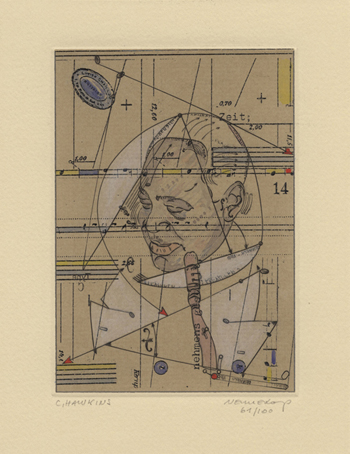The Marr Sound Archives handed me an uncatalogued box set containing 12 CD’s from the Norman Saks Collection. Each disc contains a compilation of works featuring a single jazz musician in an ensemble. I opened the linen-covered box to find not only the 12 CD’s inside but also a linen folder with 12 mind-blowing art prints by artist Johannes Vennekamp.
Vennekamp depicts the face of each of the twelve artists in pen and ink sketches with some additional coloration. Upon closer observation, the staffs, notes, clef signs, geometrical lines, and instruments depicted around and across these faces all indicate the mental processes associated with a musician’s performance style. Performers must adjust their pitch, dynamic level, and rhythm to blend and balance with the rest of the ensemble while simultaneously playing or singing the correct notes in the correct key and time signatures.
Then add to this process what the mind of a jazz performer must use in order to accomplish the additional tasks required of improvisation. These additional tasks require the musician to not only be in the current performance moment, but to also be thinking ahead to how he or she is going to serve up their variation of the melody in solo form. Their mind is now split between the current moment and a future moment in which notes should be bent, melodic phrases should be played louder or softer, a jazz scale of that key should allow an attractive solo within the melodic line, and rhythmic changes should be accomplished without losing the rest of the accompanying ensemble members.
How does one depict this mental process in artistic form?
Take the Sidney Bechet print as an example: The music staffs and notes are above, across, and below his face. The music rising from his saxophone ascends, bends and twists together like smoke rising from a familiar cigar. Or maybe the music descends from the white light of music above his head in a waterfall of splashing tones and rhythm. The music is so imbedded in his soul that it even comes out as wrinkles in his forehead.
The next example is the pianist Art Tatum’s print: Art’s mind is divided precisely by geometrical arrows of rhythm and yet the lines of music around his head are bent. The collar of his suit jacket is a treble clef staff. The picture ends with a whimsical man whose body is yet another staff. The words in German across the bottom state, “So it is.” So it is that the music will be bent and whimsical while following the rules of time and key signature.
Coleman Hawkins’ portrait depicts him taking a break from playing, with a sideways glance back to the ensemble. The bent lines around his cheeks and ears not only demonstrate that he’s listening, but that he’s pleased with what he hears. To me, the word “Zeit” (“time” in English) and the “f-hole” of the bass with the bent arrow beside it denotes that he’s listening to the drummer and bass player set him for his solo.
We’ll end with Ben Webster’s portrait. With each bent staff around him there are the words “fire, air, water, earth.” It’s as if Ben is calling forth all of the elements of the universe to accomplish his statement made through his improvised solo.
I don’t know if all of the details of these portraits can ever be absorbed, but isn’t that just like trying to improvise a melodic line? It’s always new, never predictable, in the moment yet beyond the moment. These portraits depict jazz precisely.
To see all of the portraits, feel free to come by The Marr Sound Archives and ask for “Masters of Jazz, vol. 1-12” on Storyville Records. Listen to the music as you study the portraits. You won’t regret it.
Vicki Kirby catalogs special formats metadata for UMKC Libraries.





